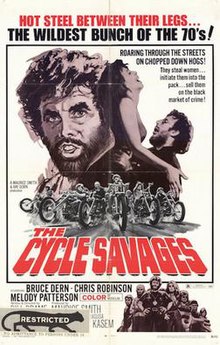

| The Cycle Savages | |
|---|---|

Theatrical release poster
| |
| Directed by | Bill Brame |
| Written by | Bill Brame |
| Produced by | Maurice Smith Casey Kasem |
| Starring | Bruce Dern Melody Patterson Chris Robinson |
| Cinematography | Frank Ruttencutter |
| Edited by | Herman Freedman |
| Music by | Jerry Styner |
| Distributed by | American International Pictures |
Release dates |
|
Running time | 82 minutes |
| Country | United States |
| Language | English |
The Cycle Savages is a 1969 American outlaw biker exploitation film written and directed by Bill Brame, and stars Bruce Dern and Melody Patterson. The film follows a biker and his crew who go after an artist who sketched his nude girlfriend. It premiered in Charlotte, North Carolina on August 22, 1969.[1] Casey Kasem served as one of the film's producers.[2]
Romko is an artist, and he's sketching biker gang leader Keeg. Keeg is running a white slavery operation in Las Vegas and doesn't want to be incriminated, so he attacks Romko, and slashes his hands to protect the gang's anonymity. One of the gangs followers, Lea, takes Romko back to her apartment and calls for Docky to help mend his hands. Docky provides the distraction while Keeg and his gang ransack Romko's apartment, and steal all the remaining sketches. Lea offers to pose nude for Romko, which leads to a romantic sexual interlude the next day. In the meantime the gang has kidnaped a local high school girl, Janie, intent in turning her to prostitution. Keeg and the entire gang rape Janie, then pump her full of a large dose of LSD. Keeg then forces another girl, Sandy, to engage in a gangbang with the gang. When the police arrive at Romko's apartment to question him about the attack that Keeg made on him, but Romko refuses to incriminate Keeg. This ends with Romko and Lea being arrested, but they are released the next day. The bikers then grab Romko, drag him to an abandoned cellar, and torture him by crushing his hands in a vice. When Lea finds them she pulls a gun, but is afraid to shoot. Then another girl grabs the gun and shoots Keeg. The rest of the gang are arrested and charged for the rape of Janie.
Gary Littlejohn recalled, "They asked me to go in there, and Bruce Dern was supposed to take my hand and squash it in a vice. I only took the job because I wanted to work with Bruce. I was working on something else at the time. I did a little riding in it and got some bikes and riders for it, that was about it."[3]
Bruce Dern recalled he was paid $1,750 a week for three weeks while Scott Brady, who filmed for one day, was paid $30,000. Dern wrote:
I played a real bad biker, and Chris Robinson played an artist and the love/romantic star of the movie. Melody Patterson was the good-looking girl star, and you just knew the filmmakers were going to have a scene where I was going to have my way with her after I took care of the artist. I had to blind him and cut his hands all up so he could never paint again. Typical Bruce Dem storyline in the sixties. I start out really horribly nasty, then turn into not really that bad a guy.[4]
Dern later wrote that while "I never worked on a movie I didn’t want to do. I did a couple of grim movies. The Incredible Two-Headed Transplant, that was a grim movie. The Cycle Savages was a grim movie. No money, no budget, no role, no script."[5]
This exploitation film–related article is a stub. You can help Wikipedia by expanding it. |